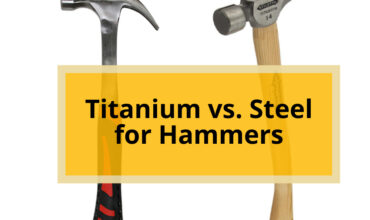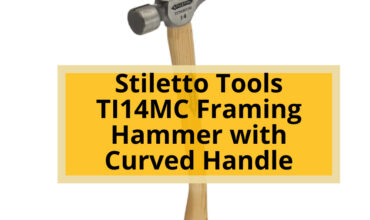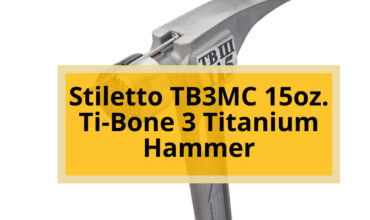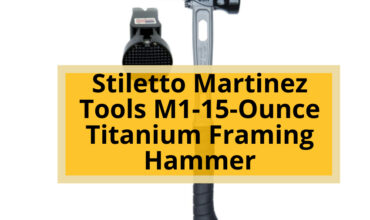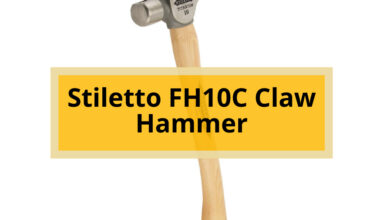There are various designs and different materials of hammer handles in the market, The question arises: Which one is the best?
There is no doubt that the best hammer handle is subjective and depends on personal preference. However, comfort, security, and withstanding the tasks and conditions the hammer will be used in are essential factors that will help you determine the best hammer handle.
In order to help you choose the best hammer handle, some points must be taken into account. Let’s discuss each one of them.
Main Aspects to Determine the Best Handle for Your Hand and Your Work Needs
When choosing the best hammer handle for your hand and work needs, there are key factors to consider: –
- Handle’s Material
- Grip Design
- Weight
- Durability
- Length
- Shock-Absorbing Technique
- Balance
Hammer Handle’s Material
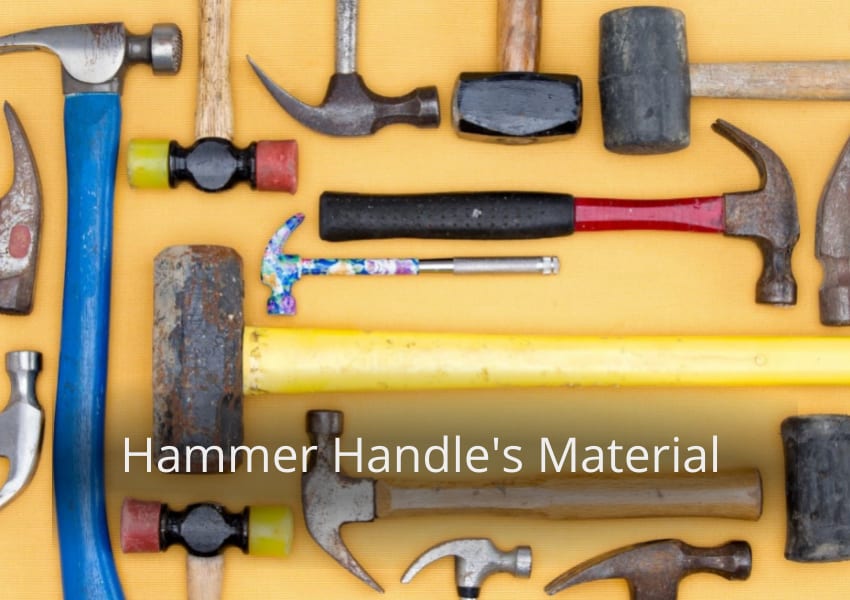
When considering the best hammer handle material for your needs, it’s essential to explore the options of wood handles, steel handles, and fiberglass handles.
Wood Handles
To get the least amount of vibration and a lightweight option, you should consider a wood handle for your hammer. Wood handles transmit the least vibration compared to metal and fiberglass. They are the lightest handle material, with most of the weight in the head.
Wood handles can be replaced if damaged and customized for personal preference. They are not as strong as steel, so not recommended for demolition work. Wood handles are preferred by framers, trim carpenters, and siding installers.
With a wood handle, you can have a comfortable and controlled grip while minimizing the impact on your body. Choose a wood handle for your hammer if you want a reliable and durable option that provides a sense of belonging to the woodworking community.
Steel Handles
Steel handles are the heaviest option but don’t necessarily increase swing power. While they may add weight to the hammer, this does not directly translate to a more powerful swing.
However, steel handles offer the highest overall strength, making them the preferred choice for masons and demo crews. These handles are robust and durable, designed to withstand heavy-duty work.
It’s important to note that steel handles can cause vibrations that may lead to injuries, so proper technique and grip are crucial.
If you’re involved in demolition or masonry work, a steel-handled hammer is recommended. It provides the strength and durability needed for these demanding tasks.
Fiberglass Handles
Fiberglass handles, favored by electricians and plumbers, transmit less vibration than steel handles. This makes them a popular choice among professionals in these trades who desire a hammer handle that minimizes hand fatigue and discomfort.
Fiberglass handles are known for their durability and affordability, making them a practical option for those who may frequently misplace or lose their hammers. These handles are non-conductive, providing added safety for electricians working with live wires.
While they may transmit slightly more vibration than wood handles, fiberglass handles are still a great option for small jobs like tacking up pipe hangers. If you’re looking for a hammer handle that offers reduced vibration and is suitable for occasional use, such as plumbing or electrical work, fiberglass handles are an excellent choice.
Handle’s Grip Design
The grip design of the hammer handle greatly impacts comfort and control during use. When considering the best hammer handle, it’s important to pay attention to the grip design.
The grip should provide a secure and comfortable hold, allowing you to maintain control over the hammer. A handle with a textured or rubberized grip can enhance your grip strength and prevent slippage, ensuring that the hammer stays firmly in your hand. This is particularly important when working in challenging conditions or when using the hammer for extended periods.
Additionally, a well-designed grip can help reduce hand fatigue, allowing you to work more efficiently and comfortably.
Handle’s Weight
When considering handle weight, it’s important to find a balance between strength and maneuverability. The weight of the hammer handle can greatly affect your performance and comfort while using the tool.
A heavier handle can provide more power and force behind each swing, making it ideal for heavy-duty tasks such as demolition or masonry work. However, it may also result in increased fatigue and reduced maneuverability.
On the other hand, a lighter handle is easier to handle and maneuver, allowing for more precise and controlled strikes. This makes it suitable for tasks that require accuracy, such as carpentry or trim work.
Ultimately, the best hammer handle weight depends on your specific needs and preferences. Finding the right balance will ensure that you can work efficiently and comfortably while achieving optimal results.
Handle’s Durability
To ensure long-lasting durability, you should consider the material and construction of your chosen hammer handle.
The durability of a handle depends on the material it is made from and how it is constructed. Steel handles are known for their strength and durability, making them a popular choice among masons and demo crews.
Fiberglass handles, on the other hand, offer less vibration transmission and are favored by electricians and plumbers.
Wood handles, while not as strong as steel, transmit the least vibration and are preferred by framers, trim carpenters, and siding installers.
When selecting a hammer handle, it’s important to choose a material and construction that matches your intended use to ensure long-lasting durability.
Handle’s Length
Consider your specific requirements when selecting a hammer. The length of the hammer handle is an important factor to consider. Most hammer handles range from 14 to 18 inches long. Longer handles can generate more force for strikes but provide less control. Some professionals prefer shorter hammers for tight spaces, as they offer better maneuverability.
The contour of the handle also plays a role in comfort and usability. Handles can be straight, curved, or hatchet style, with hatchet style handles being narrower. It is essential to choose a handle length and contour that suits your personal preferences and usage.
A Handle with A Shock-Absorbing Technique Is Essential for Your Comfort
For your comfort, look for a handle that incorporates a shock-absorbing technique.
When choosing a hammer handle, it’s important to consider your comfort and safety. A handle with a shock-absorbing technique helps reduce the impact of vibrations on your hand and arm, making your work more comfortable and reducing the risk of injuries such as hand fatigue or joint pain.
The shock-absorbing technique is typically achieved through the use of materials like rubber or gel inserts in the handle, which absorb and dissipate the vibrations caused by hammering. These handles are designed to provide a cushioning effect, reducing the strain on your body and allowing you to work for longer periods without discomfort.
Balance Between the Head of The Hammer and The Handle
The balance of the hammer is determined by the weight distribution between the head and handle. A well-balanced hammer will feel comfortable in your hand and make your work more efficient. To achieve the ideal balance, manufacturers carefully design the hammer by considering factors such as the weight of the head, the length and material of the handle, and the overall geometry of the tool.
Frequently Asked Questions
What Are Some Techniques or Features That a Handle Can Have to Help Absorb Shock and Increase Comfort?
To increase comfort and absorb shock, look for hammer handles with ergonomic designs and cushioned grips. These features help reduce strain on your hand and arm, making your work more enjoyable and less tiring.
How Important Is the Balance Between the Head of The Hammer and The Handle? Does It Affect the Performance of The Hammer?
The balance between the head and handle of a hammer is crucial. It directly affects the performance by determining the accuracy and power of your strikes. A well-balanced hammer allows for better control and reduces fatigue during prolonged use.
Are There Any Handle Materials That Are Particularly Known for Their Shock-Absorbing Properties?
Looking for a handle material known for shock absorption? Consider fiberglass. It’s favored by professionals like electricians and plumbers for its ability to transmit less vibration compared to steel.
Can the Length and Contour of the Hammer Handle Impact Its Effectiveness and Comfort During Use?
Yes, the length and contour of the hammer handle can greatly impact its effectiveness and comfort during use. A shorter handle provides better maneuverability in tight spaces, while the contour can affect grip and control.
Conclusion
Now that you have explored the different types of hammer handles and their respective advantages, you can confidently determine the best handle for your needs.
Remember, the best handle is subjective and depends on factors such as the type of work you do and your personal preferences.
Consider the strength and durability of steel handles, the reduced vibration of fiberglass handles, and the lightweight nature of wood handles.
Additionally, ensure that your chosen handle has a shock-absorbing technique for optimal comfort.
Lastly, find the right balance between the head of the hammer and the handle for improved control and performance.
Choose wisely and hammer away with confidence .

